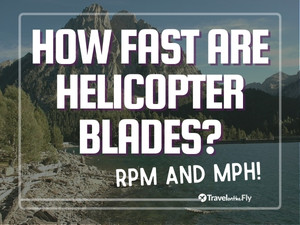RPM (Revolutions-Per-Minute) is a value used to measure the frequency/speed of something in rotation. For obvious reasons, a helicopter relies on its overhead blades’ rotation in order to produce enough lift, and thereby keep it in the air.

Most helicopters operate with RPMs of around 200-600 rpm (higher RPM rates for smaller helicopters) for the main overhead rotor with approximately a 5-6:1 ratio for the tail rotor (approximately 2500-3500 RPM). Note that the larger the rotor, the slower it turns the tip speed of the blade (aka, lower RPMs).
I will answer questions in regard to helicopter RPMs, MPH, and lift, and answer other questions I’ve received from site visitors.
Let’s talk helicopters!
What is the RPM of a Helicopter Motor?
The RPM of a helicopter motor can vary depending on the specific model and type of helicopter, as well as on the machinery’s operating conditions.
Generally, the RPM of a helicopter engine ranges from around 50-100% of the maximum rated RPM. For example, a typical helicopter engine may have a maximum rated RPM of 2,800, and the pilot may operate the engine at around 1,400-1,800 RPM during normal flight.
How Fast Do Helicopter Blades Spin in MPH?
MPH is not a relevant measure for the speed of rotating helicopter blades, and as such, helicopter blades do not have a specific MPH. It’s important to realize that the speed of the blades is dependent on the speed of the helicopter. Most helicopters typically fly at an airspeed of around 100-150 MPH, and they usually hover with a rotor tip speed of about 700 feet per second.
The top theoretical speed for a rotary-winged aircraft is about 225 knots (259 mph/417 km/h).
The current official speed record for an actual helicopter is held by a craft developed by Westland Lynx, which was clocked at a top speed of 250 mph (400 km/h) in 1986.
Its blade tips were spinning at nearly the speed of sound (Mach 1).
Can Helicopter Blades Ever Go Faster Than the Speed of Sound?
Helicopter blades are not designed to ever surpass the speed of sound, based on how a helicopter flies. If helicopter blades rotated so fast that the tips went faster than the speed of sound (Mach 1), the result would be an unmanageable helicopter.
Westland Lynx developed a craft that holds the current official speed record for a rotary aircraft which was clocked at a top speed of 250 mph (400 km/h) in 1986.
To reach this airspeed, the helicopter’s blade tips were spinning at nearly the speed of sound.
How Does Helicopter Rotor Length Affect Rotor Speed?
Rotor speed is determined by the rotor’s power and the length of the blade. Depending on the helicopter’s model and size, its blades (between 40-60 ft in length) spin at about 200 RPM to 600 RPM. The shorter the blades, the faster they can potentially spin.
It is the real speed of the rotor’s tip that determines the relevant operative condition, which is the RPM of a rotor based on its radius. Due to the fact that the lift provided by a rotor is determined by its airspeed and width, it makes sense that smaller rotors would have faster RPM than larger rotors, even though the tip speeds are generally the same.
Helicopters usually hover with a rotor tip speed of about 700 feet per second. The result is smaller helicopters (with a rotor radius of about 15 feet) featuring rotational speeds of over 400 RPMs. Large helicopters (37.5-foot rotor radius) will spin at less than 200 RPM on average.
Do Helicopters Have a Fixed RPM?
According to the Federal Aviation Administration’s (FAA) Helicopter Flying Handbook (FAA-H-8083-21B): “Helicopter rotors are designed to operate at a specific [though not necessarily fixed] RPM.
The throttle controls the power produced by the engine, which is connected to the rotor by a transmission. The purpose of the throttle is to maintain enough engine power to keep the rotor RPM within allowable limits to produce enough lift for flight.”
In regard to helicopters operating with a fixed RPM, helicopters do not have such a thing. The RPM of a helicopter’s main rotor and tail rotor are constantly adjusted by the pilot or flight control system to maintain stability and control during flight.
The RPM is also adjusted to accommodate different flight conditions and maneuvers.
How Fast do CH-47 Chinook Blades Spin?
The gigantic American twin-engined, double-rotor, heavy-lift Boeing CH-47 Chinook (used primarily for troop and supply delivery, as well as for medical and tactical troop extraction) blades operate with an RPM of approximately 225 RPM. Smaller helicopters might have blades that rotate at around 400 RPM.
Even with all its additional weight, the Chinook is the fastest rotary aircraft the U.S. Army employs, because of its twin, tandem rotors. Chinooks can carry up to 55 troops for long distances at an airspeed of nearly 200 MPH.
So, What are the RPM and MPH of Helicopter Blades?
Most helicopters today operate with RPMs of around 200-600 (higher RPM rates for smaller helicopters with shorter rotor blades) for the main overhead rotor. There is an approximate 5-6:1 ratio for the tail rotor (approximately 2500-3500 RPM). Note that the larger the rotor, the slower it turns the tip speed of the blade (aka, lower RPMs).
MPH is not an important measure for measuring the speed of rotating helicopter blades, and as such, helicopter blades do not have a specific MPH.
The speed of the blades is dependent on the speed of the helicopter. Average helicopter airspeed is about 100-150 MPH.The current official speed record for an actual helicopter is held by a craft developed by Westland Lynx, which was clocked at a top speed of 250 mph (400 km/h) in 1986.
Its blade tips were spinning at nearly the speed of sound (Mach 1). In theory, the top airspeed for a rotary-winged aircraft is about 225 knots (259 mph/417 km/h).
